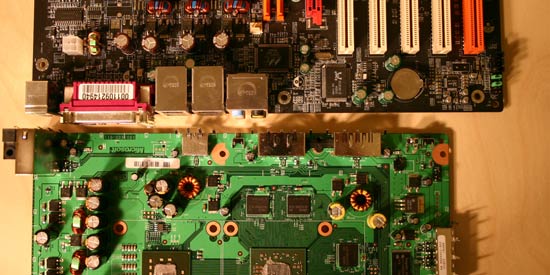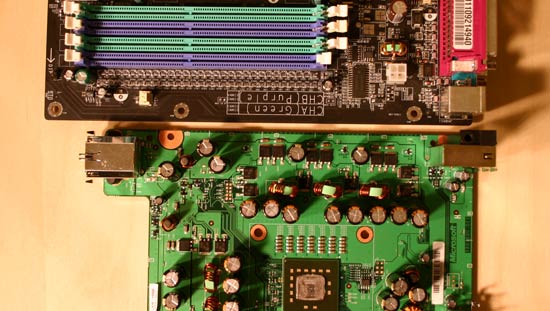Inside Microsoft's Xbox 360 - A Tour of the 360's Motherboard
by Anand Lal Shimpi on November 18, 2005 12:19 AM EST- Posted in
- Systems
On Wednesday we took apart the Xbox 360 to satisfy our curiosities and provide a tutorial to all those willing to take time out of gaming in order to take theirs apart as well. Today, we take a bit of a different approach, focusing on one item within the sleekly design chassis in particular - the Xbox 360 motherboard.
We've been reviewing motherboards on AnandTech for over eight years now, so of course taking look at the Xbox 360's motherboard in greater detail is right up our alley. Before proceeding, we recommend taking a look at our Inside the Xbox 360 article, which diagrams taking it apart as well as provides a brief overview of the technology in the system.
The original Xbox featured a 4-layer Intel motherboard, but given the incredible power requirements of the CPU and GPU on the Xbox 360's motherboard we would be astonished if the same were true today. Luckily with any console, especially early on in their life, you are getting a true bargain when it comes to the cost of hardware - so the number of layers on this PCB doesn't matter much to the end user, as Microsoft will absorb all costs above and beyond the core system's $299 price tag.
We've already shown a picture of the motherboard, but here's another shot as a refresher:

To help you orient yourself, the bottom of the picture is the front of the unit and the left of the picture is where you would see the optional hard drive. Keep this picture in mind as we go through the tour of the motherboard, as you'll see a thumbnail of this board in almost every picture in the coming pages, with the component we're discussing at the time circled in red.
The motherboard is quite small in order to give the Xbox 360 a much more slender look compared to its predecessor, which basically used a regular sized ATX motherboard. Below we have a picture of it lined up next to a standard ATX motherboard - in this case a MSI K8N Neo2:


With the size put in perspective, let's begin the tour.










27 Comments
View All Comments
Calin - Friday, November 18, 2005 - link
I don't think you can modify it now to run Linux - at least not to run Linux well. The hardware inside doesn't have yet drivers in Linux (while the CPU could be supported right now by Linux, the video probably isn't. The others probably are, but might not identify themselves as the parts they (just like the chips are engraved with Microsoft XBox 360 no matter who produce them)Alphafox78 - Friday, November 18, 2005 - link
Its way too early for that, the DRM has to be cracked first so uncoded apps can be usedPhantronius - Friday, November 18, 2005 - link
You would think Anandtech had never seen a console before judging from the way they rip into them like a 5 year old.ksherman - Friday, November 18, 2005 - link
YOU HAVE A YONAH PROCESSOR!?!?!?! is it any good? i guess it would likely be under an NDA...Great article! too bad i cant afford one of these puppies for a while... happy with my BF2 fragging machine for now!
fuzzynavel - Friday, November 18, 2005 - link
Nice pair of 360 articles....but have you actually played the damn thing yet!!!!finbarqs - Friday, November 18, 2005 - link
Yes, playing the game, are ANY games 60 FPS? 30 FPS is the previous gen, we're moving to a new era where all games needs to be 60fps... Namely Bizarre, who keeps saying that their PGr3 game will run at 60 fps... But been so quiet since they said it.. In fact, no one mentions it... Bizarre probably has a NDA on that because people will not buy the game because it didn't hit 60fps.Calin - Friday, November 18, 2005 - link
Yes, I was wondering about that too...mrgq912 - Friday, November 18, 2005 - link
I always thought those lines on the motherboards were a design element. Who ever knew it actually carried data.Learn something new on anand everyday. got a love it.
Zirconium - Friday, November 18, 2005 - link
All kidding aside, it is interesting to see the ways the board designers try to make all the traces the same length from the GPU to the memory. It also shows that the technology is so fast, that slight differences in the amount of time it takes the signal to travel can cause errors.Googer - Friday, November 18, 2005 - link
They are just like physical copper wires and those lines are not there for beauty either. Some lines carry data and others transmit the various levels of power (voltage) needed to run the components. These are the lines that keep every thing on and connected to each other.